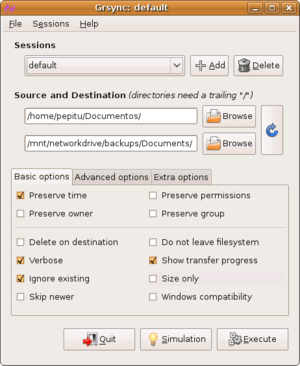Grsync
Grsync is a graphical user interface for rsync.[1] rsync is a differential backup and file synchronization tool widely used in Unix-like operating systems.
 | |
| Initial release | 17 December 2005 |
|---|---|
| Stable release | 1.2.8
/ 4 May 2020 |
| Repository | sourceforge |
| Written in | C |
| Operating system | |
| Platform | GTK+ |
| Type | |
| License | GNU General Public License |
| Website | www |
Grsync is developed with the GTK+ widget toolkit. Like rsync, Grsync is free and open-source software licensed under the GNU General Public License.[2]
About
Rsync is a well-known tool for backups in Linux system, which supplies needs to copy a group of files and folders. It can backup every local folder, support SSH tunneling, delta-only synchronization and so on.
But Grsync adds ability for such purposes in graphical user interfaces. rsync's needs learning a pretty complex set of arguments. It is much easier to backup files rather than using rsync in command-line.
gollark: Maybe they've been infiltrated by the government and sold "9/11 dust" so they won't realize the truth, which they might if they harvested it themselves.
gollark: Exactly.
gollark: How can you tell it's *real* 9/11 dust?
gollark: Get replacements and avoid it utterly.
gollark: You can just threads.
See also
Notes
- Vilsbeck, Christian (28 December 2009). "Die 13 wichtigsten Storage-Tools. Grsync - rsync-Backups komfortabel durchführen". Computerwoche (in German).
- "Grsync". SourceForge. Retrieved 21 June 2020.
References
- Kereki, Federico (14 April 2009). "The rsync family". developerWorks. IBM.
- Dirscherl, Hans-Christian (20 July 2009). "Daten-Backup mit Grsync". Freenet (in German).
This article is issued from Wikipedia. The text is licensed under Creative Commons - Attribution - Sharealike. Additional terms may apply for the media files.